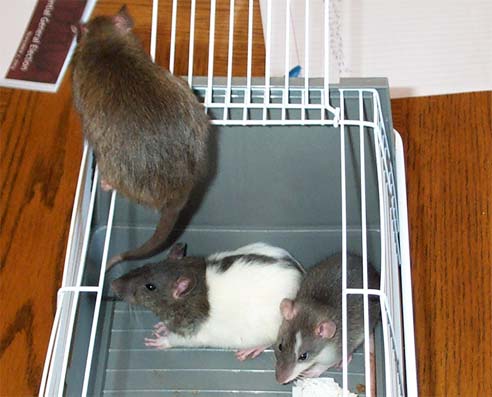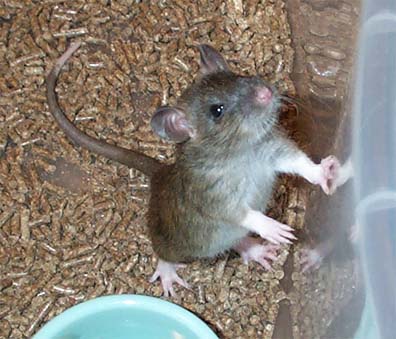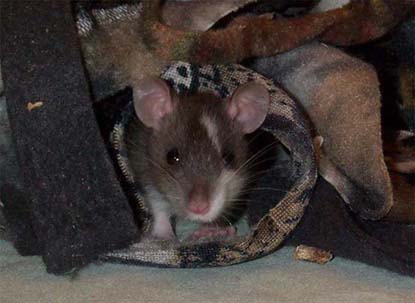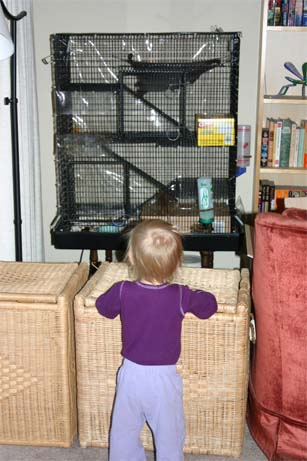|
|
|
|
I spent about an hour and a half at the rescue with a little cage of babies from two litters, playing with them all and watching them. Five or six of them stayed hidden most of the time, so I didn't bother them. The other five or six came out to exlore, check me out, run back, return, and bounce about. All were tame and hand reared, but I wanted the very friendliest ones.
A charming little blazed agouti came out onto my lap again and again... no sooner did I pop him back in the cage than he was out again. A beautiful reddish agouti was always on the edge of the cage or crawling on my lap, and when I picked him up he felt calm and confident in my hands. I choose those two first and put them in my carrier so I could focus on a third.
The third was a little harder to choose... there were
several agoutis who climbed out but I could not tell which one was
which, and I did want rats that looked different enough to tell them
apart from the ones I had. A little agouti hooded caught my
eye. He was an intrepid little guy, jumping out of the cage
onto me or in an attempt to get out to explore. Several times
he slithered down the side of the cage and was on his way into the
wide world before I could grab him. I'd hold him and he'd tense up a
bit and scurry to get back in the cage... but as soon as his
feet hit the bedding he'd turn around and climb right back up into my
lap. He couldn't make up his mind! Gradually all the rats in the cage
calmed down and piled in a corner, but the little agouti hooded kept
trying to get out and onto my lap and into the great blue
yonder. So I picked him.
|
|
|
|
The following evening, I covered the dining room table with some cloth, and put some boxes, a paper bag, and a pile of polar fleece strips on it, and let the little guys out to play. The blazed rat was the first one bold enough to venture out. The other two were more hesitant, and took a little prompting. But afer ten minutes all three were romping around the table, hiding in the bag, hiding in the boxes, and burrowing in the polar fleece. Here are some photos of their first play session!
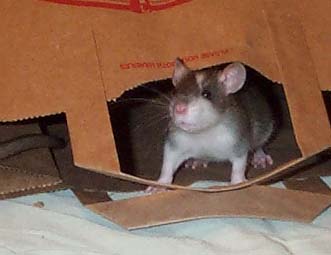
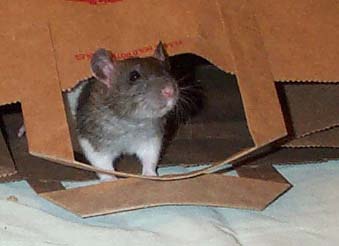
|
|
|
|
I got them a big Martin's cage (R-695). At first they lived in the home office with the two cages containing the aging Snip and Widget, who were each other's mortal enemies. So for several months there were three cages in that room, which made cage cleaning day quite an event! It also meant that a lot of my attention was drawn toward my two older guys, especially toward Snip, who was such a loveable elder rat.
Widget and Snip eventually passed away in the spring of 2005. In the summer of 2005 we converted the home office into the baby's room. We moved the rat cage into the dining room. They had a great view in their new quarters -- they got to watch us eat dinner, and consequently, they got lots of treats. They eagerly devoured bits of broccoli, corn cobs, grains of rice, a noodle or two, and the occasional chicken bone... whatever odds and ends we gave them from our meals. The dining room definitely had its perks. As I do with all my rats, I trained them to come to the top of the cage for a treat when I make a specific sound. It's good to have rats trained come when you call, because sometimes you need to get a hold of them right away (say, for a trip to the vet) and it is exasperating to have to chase them around the cage. And, in the case of free range time or an accidental escape, it is very convenient to be able to call the rat and have it come right to you.
These three guys were raised on lab blocks at the rescue and I decided to keep them on that diet. This was a switch because I had cooked a custom diet for my two previous colonies. I'd whip up a big batch of wet and dry mixes and freeze the wet mix in ice cube trays and keep the dry mix in a huge sealed bowl. The dry mix, which was available ad libitum, consisted of cereals, dry pasta, and Nutro Lite dog food. The wet mix was served every evening and varied from month to month, but it ususlly contained brown rice, vegetables, beans, canned fish and crushed vitamins. However, this home made diet was labor intensive, and with our lives getting very busy in the near future (birth of first child), continuing to cook for the rats just didn't look sustainable. Lab blocks were a balanced diet and these little guys had never known anything else, so I kept them on the blocks. And I must say that after two years on lab blocks, they are thinner and more trim than Cricket, Widget and Snip were at the same age. By their third year, Cricket and Snip had become quite fat.
Bobbin, Tucker and Grommet enjoyed the food puzzles I gave them -- particularly the empty egg carton taped shut with dog food in it. They'd knock this around the cage, sniffing and tearing, until they managed to turn it upside down and a few kibbles would fall out of the holes and reward them. Eventually, they'd chew their way in. Whenever we finished a dozen eggs the rats would get the carton. They also enjoyed toilet paper tubes with the ends pressed closed, containing dog food as well.
Tucker and Grommet were brothers, and both had the same reddish agouti rex fur, and the same physical build, face, and eyes. They were quite different in personality, however. Grommet was a highly strung rat. When picked up, his body quivered with agitation and he'd immediately start wriggling away to explore, or at least to get away from being confined in a human hand. He was quite tame, but never really enjoyed being held. In the past three colonies of rats I've had, there was always one rat that was particularly "ratty," a rat's rat, an animal that was most interested in other rats and not particularly interested in humans. Smudge, Widget, and now Grommet had that kind of "ratty" personality.
Grommet started out as dominant rat in the little colony of three, and snatched his treats away from the other two and terrorized them. If they crept forward, a milimeter at a time, whiskers splayed forward, and dared to touch his treat he would fly at them and beat them back. They learned soon enough to let Grommet have first dibs on any goodies in the cage.
|
|
|
|
In contrast, Tucker was a very relaxed, laid-back rat who usually let Grommet and Bobbin steal treats from him without ever lifting a paw in self-defense. He'd simply wait until the other two had their treats, then he'd amble off with the third treat and eat it in a corner. He was a big loveable red rat, a delight to hold and pet (in fact, his full name was Tucker Red). His squishiness reminded me of Snip, but his laid-back attitude toward his cagemates reminded me of Cricket. Tucker was an unruffled, relaxed, simple rat.
Bobbin was the handsomest rat of the three. He had a beautiful, thick grey fur flecked with white, a gorgeous white belly and feet and blaze. His head was exquisitely formed, and his eyes and ears were big and handsome. His fur was amazingly thick, almost like a beaver pelt. His personality and social position in the cage were complex. Towards humans, he was very tame and laid-back. He was a big squishy male rat who'd lay on my arm and brux while I rubbed his shoulders. He was a bit of a bully toward Tucker, and he grappled with Grommet for power in the colony. Bobbin was unrelated to the other two, but had lived with them since the age of five weeks. He started out as the youngest and smallest of the three, which put him at a social disadvantage for a long time. As the rats aged, however, Bobbin took on weight and eventually became the largest of the three. He vied with Grommet many times, and by the end of their second year it was difficult to tell who was ahead. In fact, it looked more like situational or perhaps shared dominance, with Grommet making off with a treat from Bobbin sometimes, Bobbin absconding with one of Grommet's at others.
Overall, however, the cage was a very peaceful place with few altercations of any sort. The few disagreements were settled without bloodshed, which was quite different from Cricket, Widget, and Snip's colony, in which Widget terrorized and eventually bit the other two and had to be separated. I think the rats' personalities had a lot to do with the lower level of aggression -- Grommet and Bobbin were just less aggressive than Widget. Another factor, however, was the large cage they lived in. All the rats had a lot of space and they were never cornered. This space probably prevented fights from escalating.
As it turns out, our human baby was absolutely fascinated by the rats. We moved the cage out of reach but still within sight, and nothing pleased her more than to stand a few feet away from the cage, watching the rats climb up and down the ramps. It was her great joy, and I understand it completely. Before she could even talk the baby learned to imitate the sound I used to call the rats, and she'd stand next to the cage and imitate mommy, trying to call the rats out herself. A few weeks after she learned to call them, her love for them motivated her very first word: "Rats" (or as she would say, "aaaaaaaaats").
The rats enjoyed good health for most of their lives. They had no serious respiratory problems and never needed to go on antibiotics for myco. Grommet had an abscess removed, but otherwise that was it until they were over two years of age.
Things started to go downhill a few months into the third year. Grommet developed a deep, invasive tumor which turned out to be inoperable. He was euthanized during surgery on January 10, 2007, at the age of 2 years and 4 months.
In early January, 2007 Bobbin developed untreatable neurological leg weakness which made him drag his hindquarters and gradually progressed over several weeks to involve his front paws. He continued to be in good spirits and was able to eat, drink and feed himself even after the condition appeared. After a lifelong diet of lab blocks, we fed him soft, easy-to-eat table scraps and human food for the last month of his life, which he (and Tucker) enjoyed immensely. Bobbin died on February 19, 2007.
Compared to the other two, and to my previous rats, Tucker's old age was uneventful and graceful. He strolled about, climbed into his hammock, and enjoyed treats right up to the end. He just got slower and more stiff, his breathing became more labored, and he tired very easily. But he had no tumors, respiratory illnesses, or paralysis; there was no lingering or suffering. Tucker just ambled through the end of life much like he had lived it: laid back, easy going, and peaceful. In the end, I think he was just resting with his head looking out of the nestbox like he often did, gazing at the world... and he slipped away. May we all have an end that is so peaceful.
- Bobbin: 9/28/04 - 2/19/07. Age 2 years and 5 months.
- Tucker: 9/15/04 - 3/23/07. Age 2 years and 6 months.
- Grommet: 9/15/04 - 1/10/07. Age 2 years and 4 months.
